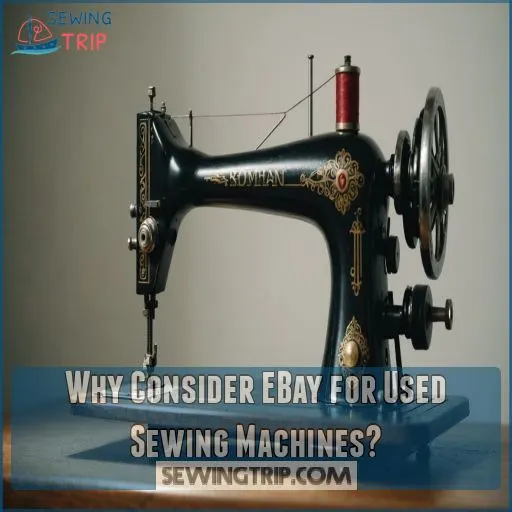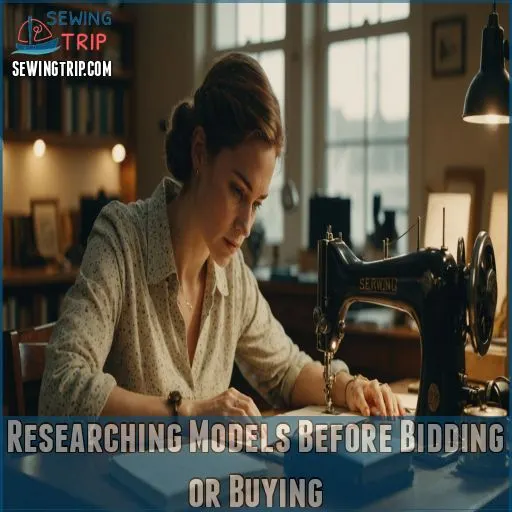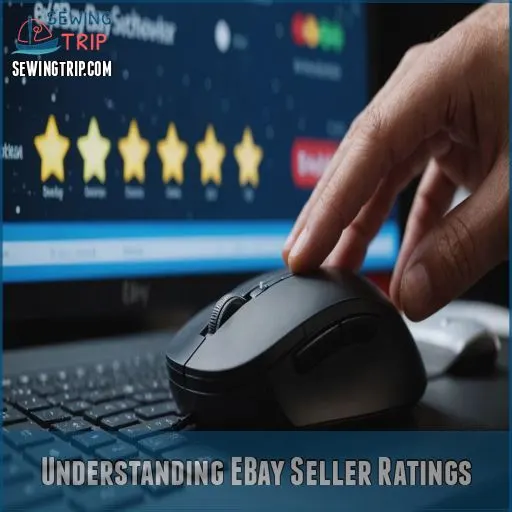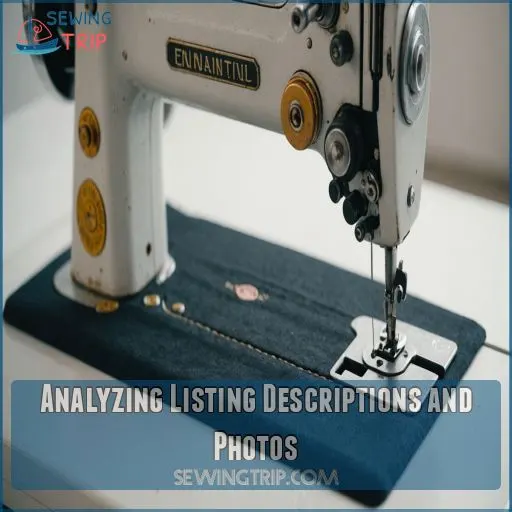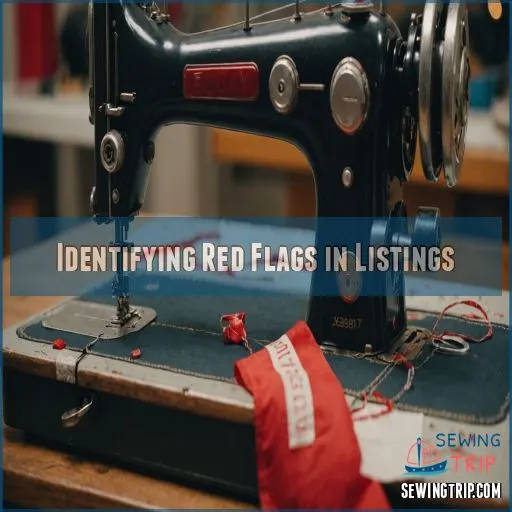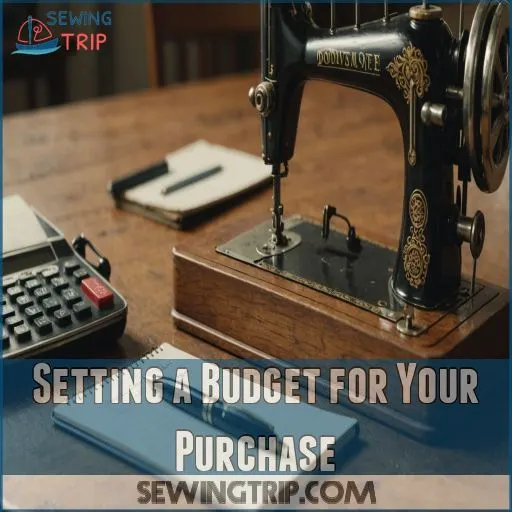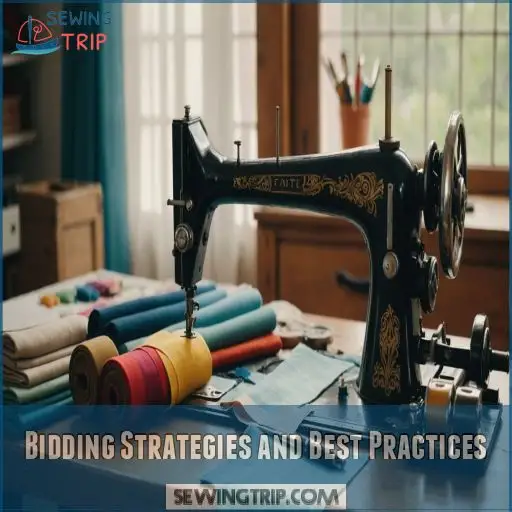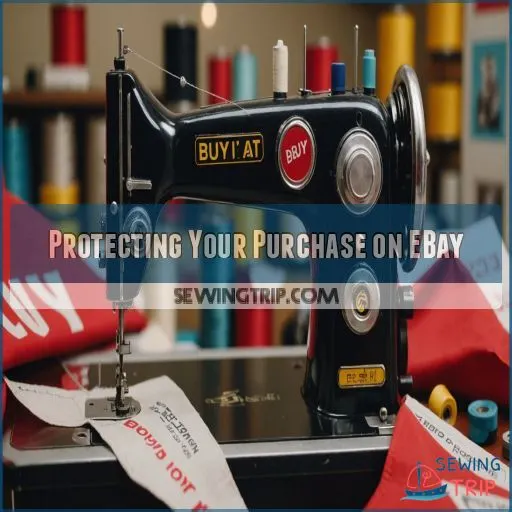This site is supported by our readers. We may earn a commission, at no cost to you, if you purchase through links.
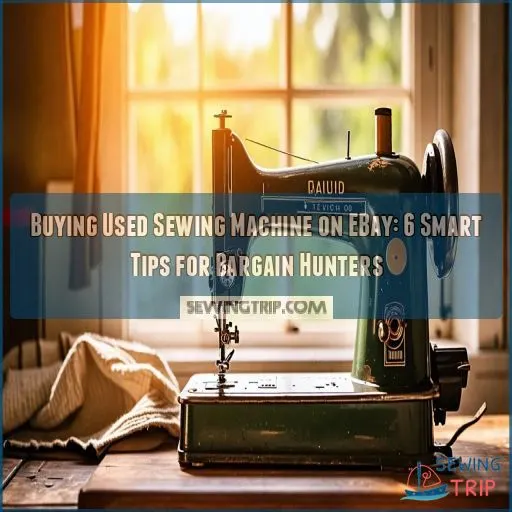 You’ll love buying a used sewing machine on eBay – it’s like treasure hunting for crafters!
You’ll love buying a used sewing machine on eBay – it’s like treasure hunting for crafters!
Start by researching models that match your needs, whether you’re eyeing a reliable Singer or a vintage gem.
Check seller ratings carefully and scrutinize those listing photos like a detective.
Set a firm budget that includes shipping costs, and don’t forget to factor in potential parts or servicing.
When bidding, timing is everything – seasoned eBay shoppers know the best deals happen on quiet weekdays.
Just remember to read descriptions thoroughly and watch for red flags like missing maintenance records.
There’s a whole world of smart bidding strategies waiting to help you snag that perfect machine.
Table Of Contents
Key Takeaways
- You’ll find a wide selection of used sewing machines on eBay, from popular brands to vintage models, often at better prices than buying new.
- Before bidding, research different models to match your needs, set a firm budget that includes shipping costs, and scrutinize seller ratings and listing photos.
- Use eBay’s automatic bidding system, time your bids strategically (often in the final seconds), and avoid getting caught up in bidding wars to snag the best deals.
- Protect your purchase by using secure payment methods, documenting the transaction, and understanding eBay’s Buyer Protection policy in case of disputes.
Why Consider EBay for Used Sewing Machines?
EBay offers a wide selection of used sewing machines, from popular brands to vintage models. You’ll find potential deals and can easily compare prices across listings.
Wide Selection of Models and Brands
Anyone hunting for a used sewing machine will find eBay’s vast marketplace a treasure trove, offering more affordable options compared to buying new machines from dealers.
You’ll discover popular brands like Singer and Brother, alongside rare vintage models.
From basic mechanical machines to computerized wonders with hundreds of stitches, eBay’s got it all, including a wider selection of used machines, including rare and collectible machines, that may be hard to find elsewhere Access to rare models.
It’s like a sewing machine buffet where you’re in control of the menu!
Potential for Great Deals
Bargain hunters, listen up! eBay’s a treasure trove for budget-friendly sewing machines. You’ll find hidden gems and score great deals on secondhand machines.
Sellers often offer discounts, and you can negotiate prices to fit your budget. With millions of buyers and sellers, competition drives prices down .
You’re in control – set your max bid and let eBay’s system work for you. It’s a win-win for your wallet and your crafting dreams.
Access to Vintage and Discontinued Machines
EBay opens doors to sewing machine history.
You’ll find vintage models and discontinued brands that aren’t available in stores.
These machines often have unique features and charm.
Some sewers swear by older Berninas for their reliability and stitch quality (Source).
You might even stumble upon rare parts for restoration projects.
Just remember, older machines may need TLC or repairs.
It’s a treasure hunt for sewing enthusiasts!
Opportunity to Compare Prices Easily
In a flash, you can compare prices for used sewing machines on eBay.
Use price comparison tools to track market values of Kenmore, Janome, and other brands.
Analyze price trends and history to spot deals.
You’ll gain control over your purchase, mastering the art of competitive pricing.
It’s like being a bargain-hunting detective, uncovering hidden gems and avoiding overpriced lemons.
Researching Models Before Bidding or Buying
Before jumping into the used sewing machine market on eBay, arm yourself with knowledge.
Research different models to find the perfect match for your needs.
Start by identifying key sewing machine features that matter most to you:
- Stitch types: straight, zig-zag, blind-hem, and automatic buttonhole
- Adjustable stitch length for versatility
- Work space: ample room for larger projects
Compare machine capabilities and read user reviews to gauge performance and reliability.
Don’t forget to check price comparisons across various sellers.
Consider your specific user needs, like heirloom sewing or quilting.
Look into available sewing machine parts and accessories for each model.
Some must-have features include needle down position, mirror imaging, and automatic thread cutting.
By doing thorough sewing machine research, you’ll be better equipped to make an informed buying decision and snag a great deal on your dream machine.
Evaluating Seller Reputation and Listings
You’ll want to check seller ratings and scrutinize listings when buying used sewing machines on eBay.
Look for clear photos, detailed descriptions, and watch for red flags to make sure you get a good purchase.
Understanding EBay Seller Ratings
When buying a used sewing machine on eBay, research the brand to ensure you’re not getting a low-quality model from a manufacturer like Vof chinese imports. Deciphering eBay seller ratings helps you make smart sewing machine purchases.
You’ll want to focus on feedback scores and detailed ratings.
Check the seller’s star color and number – they indicate experience and reliability.
Here’s a quick guide to understanding seller performance:
| Rating Category | What It Means | Why It Matters |
|---|---|---|
| Feedback Score | Percentage of positive reviews | Higher is better |
| Detailed Seller Ratings | Scores for item description, communication, shipping speed, and charges | 5 stars is the best |
| Feedback History | Trends over time | Look for consistency |
| Cases Closed Without Resolution | Unresolved buyer issues | Fewer is better |
| Transaction Defect Rate | Problems per sale | Lower rates indicate reliability |
Analyzing Listing Descriptions and Photos
Scrutinize listing descriptions and photos like a detective.
Look for clear, detailed images showing the machine’s condition.
Check for close-ups of any wear or damage.
Read descriptions carefully, noting specifics about functionality and maintenance history.
Don’t be fooled by buzzwords like "industrial strength" – true industrial machines have distinct features.
Compare motor sizes and capabilities to gauge a machine’s real power.
Remember, honest sellers provide thorough information and high-quality photos.
Identifying Red Flags in Listings
You’ve analyzed the listing, but watch out for red flags. They’re like icebergs – what you see isn’t always what you get.
Keep your eyes peeled for these warning signs:
- Missing photos of important parts
- Vague descriptions that don’t match the pictures
- Unreasonably high shipping costs
These could signal a seller trying to pull the wool over your eyes. Trust your gut – if something seems fishy, it probably is.
Setting a Budget for Your Purchase
Before committing to a used sewing machine, consider if it’s been properly maintained through regular lint removal and servicing, as this can significantly impact its performance and lifespan. You’ll need to set a budget for your used sewing machine purchase on eBay. Consider the fair market value, shipping costs, and potential expenses for parts or accessories.
Determining Fair Market Value
Now that you’ve assessed the seller, let’s talk money.
To avoid buying a used sewing machine that may have underlying issues, such as a sewing machine runs on its own problem, pinpointing a fair price for a used sewing machine is like solving a puzzle.
You’ll want to compare prices, consider the machine’s condition, and factor in brand reputation.
Here’s a quick guide to help you budget wisely:
| Factor | Impact | Example |
|---|---|---|
| Brand | High | Singer vs. off-brand |
| Age | Medium | Vintage vs. recent model |
| Condition | High | Like-new vs. needs repair |
| Features | Medium | Basic vs. computerized |
| Recent sales | High | eBay completed listings |
Remember, a fair price is what you’re willing to pay (Source).
Happy hunting!
Factoring in Shipping Costs
Don’t let shipping costs catch you off guard.
Check the shipping weight and get accurate quotes before bidding.
Heavy machines can rack up hefty fees.
Consider shipping insurance for peace of mind, especially for vintage gems.
Factor in shipping time – you might need that machine sooner than later.
Watch out for potential shipping damage; sellers should pack securely.
Remember, a bargain isn’t a bargain if shipping eats your savings.
Considering Additional Expenses (Parts, Accessories)
The savvy sewing machine hunter knows a bargain isn’t just about the sticker price.
Factor these essential extras into your budget: determine your budget and stick to it, as sewing machines can range from under $100 to over $1,000, but you can find great value for money in the $100-$200 cheap sewing machine budget.
- Replacement parts (needles, bobbins)
- Accessories (presser feet, extension table)
- Servicing costs (yearly tune-ups)
- Shipping fees
Create a checklist of potential add-ons before bidding.
This way, you’ll have a clear picture of the true cost and avoid any budget-busting surprises.
Remember, a well-equipped machine is your ticket to sewing freedom!
Bidding Strategies and Best Practices
You’ll need smart bidding tactics to snag that perfect used sewing machine on eBay.
Set maximum bids, time your offers wisely, and use eBay’s automatic bidding system to boost your chances of winning without overpaying.
Setting Maximum Bids
You’ve got the power to control your bidding fate.
Set your maximum bid wisely to stay within budget and avoid overpaying.
Consider these key factors:
| Factor | Consideration |
|---|---|
| Fair value | Research market prices |
| Bid increment | Adjust for auction dynamics |
| Budget limit | Stick to your spending cap |
Remember, your max bid is your secret weapon.
It lets you compete without constantly monitoring the auction.
Stay cool, set your limit, and let eBay’s system do the bidding dance for you.
Timing Your Bids Effectively
Mastering the timing of your bid can be crucial in securing a great deal on a used sewing machine, especially considering the rich history of innovations in sewing machines, with milestones like the first working machine patented by Elias Howe’s Design. Mastering bid timing can make or break your sewing machine deal.
Weekends often see peak bidding times, so aim for slower weekdays.
Place your highest bid in the closing seconds to outmaneuver other bidders.
Late-night auctions typically attract fewer competitors, increasing your chances of snagging a bargain.
Remember, eBay’s marketplace is like a bustling bazaar – you’ve got to know when to strike for the best deals.
Using EBay’s Automatic Bidding System
Savvy eBay shoppers harness automatic bidding for a stress-free experience.
Set your maximum bid and let eBay do the work.
Here’s how to make the most of this feature:
- Enter your highest price and click "Place bid"
- eBay bids incrementally on your behalf
- Stay updated on your bidding status
Remember, shipping costs add to your total.
Think of your max bid as a promise to pay if you win.
It’s like having a silent auction partner working for you 24/7.
Avoiding Bidding Wars
In the heat of eBay bidding, keep your cool and avoid costly wars.
Set a firm limit and stick to it.
Time your bids strategically, often in the final seconds.
Watch your competitors’ patterns but don’t get caught up in their frenzy.
Remember, patience is your ally.
If the price soars beyond reason, know when to fold and wait for the next great deal.
Protecting Your Purchase on EBay
You’ve found the perfect used sewing machine on eBay, but your work isn’t done yet. Protecting your purchase is important, from understanding eBay’s buyer protection to using secure payment methods.
Understanding EBay Buyer Protection
Smart bidding pays off, but you’ll want reliable protection for your sewing machine investment. EBay Money Back Guarantee offers you peace of mind with automatic coverage at no extra cost.
Here’s what you should know about buyer protection:
- You’re covered if the machine doesn’t arrive or doesn’t match the listing description
- Coverage activates automatically when you pay through eBay’s checkout system
- You have direct access to the eBay Resolution Center for disputes
- Claims must be filed within eBay’s specified timeframes for coverage
Remember, this protection isn’t a product warranty, but it’s your safety net against potential purchase problems.
Using Secure Payment Methods
Protecting your precious investment starts with choosing trusted payment options on eBay.
You’ll want to stick with PayPal, credit cards, or digital wallets like Apple Pay and Google Pay – they’re all covered by eBay’s Money Back Guarantee.
Skip those risky cash transfers or Western Union payments.
Think of secure payments as your safety net – they’ll keep both your money and your sewing dreams protected while you shop.
Documenting The Transaction
Take screenshots of your purchase details and save all messages between you and the seller, as thorough inspection is essential even when buying a well-maintained, lightly used embroidery machine guide.
Keep a digital folder with payment confirmations, shipping tracking numbers, and listing photos – they’re your safety net if things go sideways.
Log every step of your transaction, from initial contact to delivery confirmation.
Store the original listing description too, since sellers can modify them later.
Filing Claims for Issues or Disputes
When things go sideways with your sewing machine purchase, you’ve got the power to make it right through eBay’s dispute resolution system. You’ll want to start by reaching out directly to the seller through eBay’s messaging system to resolve any issues amicably.
Here’s your action plan for handling disputes:
- Document everything with clear photos and save all communication with the seller
- File a formal complaint through eBay’s Resolution Center if direct communication fails
- Consider using SquareTrade‘s free mediation service for unbiased dispute resolution
Frequently Asked Questions (FAQs)
Can you buy a sewing machine on eBay?
Shipping damage shouldn’t stop you!
When purchasing a used sewing machine, consider your sewing needs and budget by evaluating the types of projects you’ll tackle and the machine’s features, such as durable motor strength. You can confidently buy sewing machines on eBay if you choose sellers with expertise in machine packaging.
Insist on double-boxing, insurance coverage, and return policies for seamless shopping success.
Where can I sell a used sewing machine?
You’ll find multiple profitable options for selling your sewing machine.
List it on eBay with detailed photos and working demonstrations.
Connect with specialty buyers who purchase all brands.
Or try local classified ads for convenient transactions.
Should you buy a sewing machine online?
Did you know 90% of sewers test-drive machines before buying?
Buying online can save you money, but you’ll miss out on in-store perks.
Try machines locally, then compare prices online for the best deal.
How much does a used sewing machine cost?
Used sewing machine prices vary widely.
You’ll find vintage models for as low as $95 and more recent ones around $
Factors like brand, condition, and features greatly influence cost.
Always check seller ratings before purchasing.
Is it worth buying a used sewing machine?
Buying a used sewing machine can be a smart choice.
They’re often sturdy, environmentally friendly, and cheaper than new models.
You’ll get more bang for your buck, especially if you’re a beginner or have limited space.
What to look for when buying a second hand sewing machine?
Check the machine’s appearance, finish, and decals.
Inspect for scratches or dings.
Consider shipping costs for heavy vintage models.
Make sure it’s in good working order.
Test before buying if possible.
Look for reputable sellers offering warranties.
Is there a market for old sewing machines?
Many sewers swear by vintage sewing machines for their durability and lifespan comparison. Old sewing machines have a thriving market.
You’ll find collectors coveting rare models like Singer Featherweights, which can fetch thousands.
Everyday vintage machines still sell for $50-$200, appealing to both hobbyists and decorators seeking unique pieces.
How much should you pay for a good sewing machine?
Good sewing machines typically range from $200 to $
You’ll get quality without breaking the bank.
Consider your needs and budget.
Don’t overpay for features you won’t use.
Research and compare prices to snag a deal.
Can I return a used sewing machine?
You can return a used sewing machine, but it depends on the seller’s policy.
Many offer 30-day returns (Source).
Always check the return policy before buying.
Make sure you package it properly to avoid damage during shipping.
How much does shipping typically cost?
Ironically, shipping costs can weigh more than your sewing dreams.
Typically, you’ll spend $20-$50, depending on machine size and distance.
Factor in weight, dimensions, and carrier rates.
Don’t let hefty fees unravel your plans – calculate costs beforehand.
Which brands hold their value best?
Bernina machines consistently hold their value best.
Mechanical models outperform computerized ones in retention.
Brother and Baby Lock offer good value.
Consider Singer for vintage appeal .
Ultimately, a machine’s condition greatly impacts its worth.
Should I request service history from sellers?
Requesting service history is essential.
It reveals a machine’s condition and potential issues.
Ask sellers for maintenance records, repairs, and last service date.
This information helps you gauge reliability and make an informed decision when purchasing.
Are international listings worth considering?
Consider international listings cautiously.
They might offer unique machines, but you’ll face higher shipping costs and potential import fees.
Check seller ratings carefully and factor in currency exchange rates.
Ultimately, weigh the risks against potential savings or rare finds.
Conclusion
Did you know that 80% of eBay sewing machine buyers report satisfaction with their purchases?
Armed with these six tips, you’re ready to join their ranks.
Remember, buying used sewing machines on eBay is about smart research, careful evaluation, and strategic bidding.
Set your budget, scrutinize listings, and time your bids wisely.
With patience and savvy, you’ll snag a great deal on a quality machine.
Happy hunting, and may your future projects be stitched with success!

